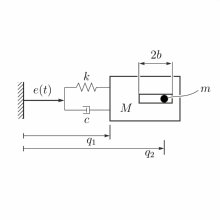The growing trend to build light weight structures, which by their slender nature are more prone to structural vibrations, greatly increases the need to overcome limitations caused by vibration problems. The encountered vibrations are generally mitigated by the use of dynamic vibration absorbers. The effective frequency range of dynamic vibrations absorbers can be enlarged by making sophisticated use of nonlinearities, leading to so-called Nonlinear Energy Sinks (NESs).
The focus of our research is placed on nonsmooth vibration absorbers, in which the absorber mass is attached to the main structure through a nonsmooth coupling. In particular, we study the working principle of a Vibro-Impact NES, i.e. a small mass undergoing impacts within a cavity in the main structure. The vibration suppression of the Vibro-Impact NES relies on the local dissipation due to impacts as well as on the transfer of the main system’s energy induced by the impacts. This phenomenon is called Targeted Energy Transfer and is active within a broad frequency range, being tuned through the NES. To ensure an effective suppression of unwanted vibrations, these mechanisms and the resulting dynamics have to be examined. This calls for a complete identification process including a combination of theoretical and numerical analysis, validated and verified through laboratory experiments.
However, conventional linear identification methods and techniques fail when faced with nonlinear systems with high modal density. As an example, a harmonic external forcing on a structure with nonlinear stiffness can generate non-unique steady-state responses depending on the initial conditions. Furthermore, the superposition principle does no longer hold in the presence of nonlinearities. The conventional modal analysis based on the orthogonality of linear modes breaks down. Still, for weakly damped nonlinear structures, the skeleton of the nonlinear frequency response and resonances is governed by so-called nonlinear modes, which in many cases may be seen as the extension of linear modes into the nonlinear regime. The concept of nonlinear modes represents an important framework for the analysis of nonlinear vibrating structures, but has been developed for smooth nonlinearities. This leads to a second, more fundamental, focus of our research which studies the concept of nonlinear modes of nonsmooth systems and their identification. Combined analytical-numerical approaches are used to investigate and identify the fundamental properties of nonsmooth nonlinear modes. The objective is to pave the way towards an effective and practical computation of the nonsmooth nonlinear modes, allowing the prediction of the system’s behavior under different external conditions.
Journal
- Youssef, B., & Leine, R. I. (2021). A complete set of design rules for a vibro-impact NES based on a multiple scales approximation of a nonlinear mode. Journal of Sound and Vibration, 501, Article 116043. https://doi.org/10.1016/j.jsv.2021.116043
Contact

Balkis Youssef
M.Sc.
Remco I. Leine
Prof. Dr. ir. habil.director





